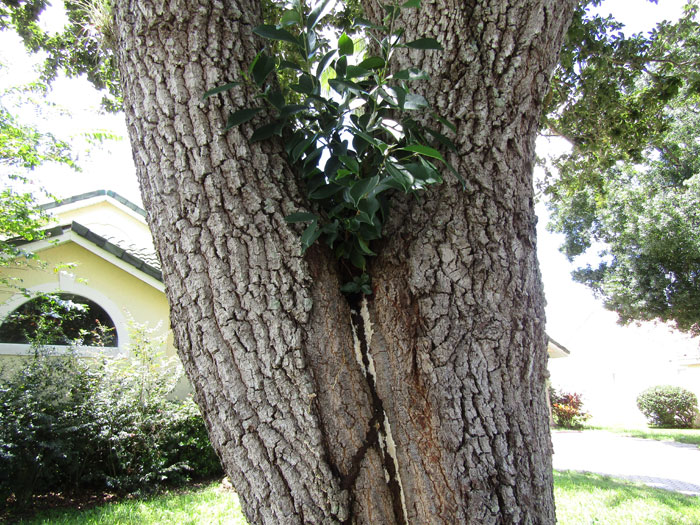Hopefully we won't experience such damage from future hurricanes but there is more than two months of hurricane season left, so take time to check your trees. Do it yourself or have a certified arborist stop by to help with the tree evaluation - it's just good insurance.
Some trees are just suspect. Once a laurel oak grows more than 40 to 50 years old it seems to fill with weak joints, rotting roots and hollow trunks. These are the first to split and topple over. Trees with root problems and those near sidewalks or drives are the first to fall too. Look for twin trunks of all trees that are pushing apart. These will be the first to split in storms. Also check for hollows in trunks that may mean the interior portion is rotting. Sap flowing down trunks is another sign a tree is in trouble. If you see any of these signs, the tree needs to be checked.
Some trees like the Chinese elms and tabebuias seem to be more shallow rooted and likely to blow over. Most trees in shallow soils or soils with a high water table that limits root growth are also likely to blow over during hurricane winds.
Now, don't give up on trees. Have the needed pruning performed to hurricane proof your trees before the next major storm arrives. In local surveys, gardeners that had needed pruning performed suffered little if any damage. Then, if you have to replace a tree or just need a shade giver think of what you might plant for replacements.
Large live oaks and bald cypress seem to be good survivors. Also, most sweet gums and sycamores sustain minimal damage. When picking replacements, you might think small. Some selections still standing after major storms within the 20 to 35 foot range include crape myrtles, hollies, red bud, sand live oaks, tree ligustrums and winged elms. Lastly keep all new plantings 15 to 20 feet from the home, sidewalks and driveways if at all possible to allow the trees to make good root growth.
Trees severely affected by previous hurricanes
- Chinese elms - variety Drake elm mainly planted locally
- Hickories - mainly poorly rooted and older specimens
- Laurel oaks - mainly trees over 40 to 50 years
- Pines - variable damage
- Red cedar - older specimens
- Red maples
- Tabebuias
- Weeping willows
Normally hurricane survivors
Large trees - over 35 feet:
- Bald cypress
- Live oaks
- Magnolias
- Sycamores - some damage
- Sweet gums - some damage
- Hollies
- Japanese blueberry
- River birch
- Sand live oak
- Winged elms
- Crape myrtles
- Ligustrums
- Tree ligustrums
- Red buds
Palms :
- All normally are good survivors
- Some bud breakage has been reported with queen palms.

